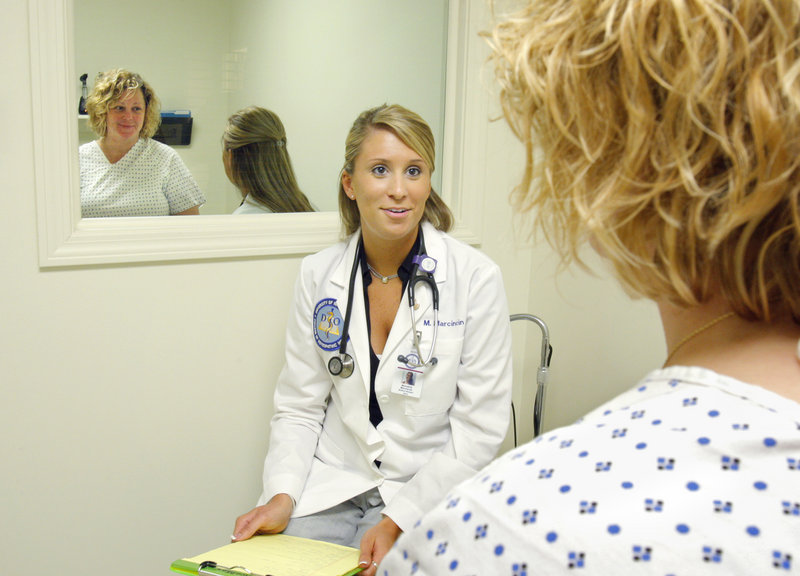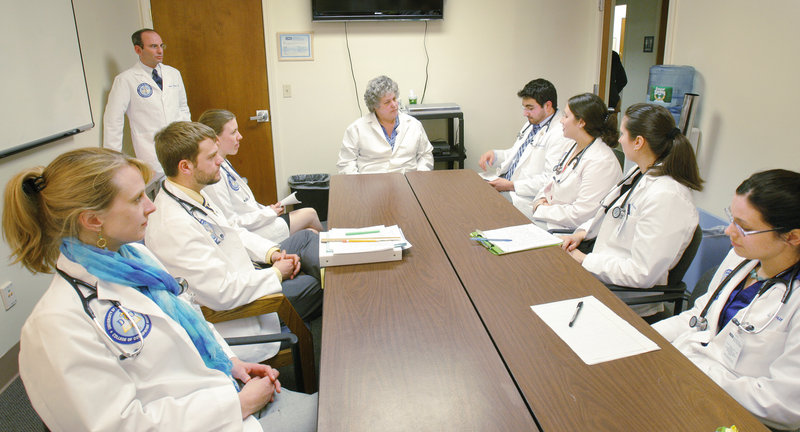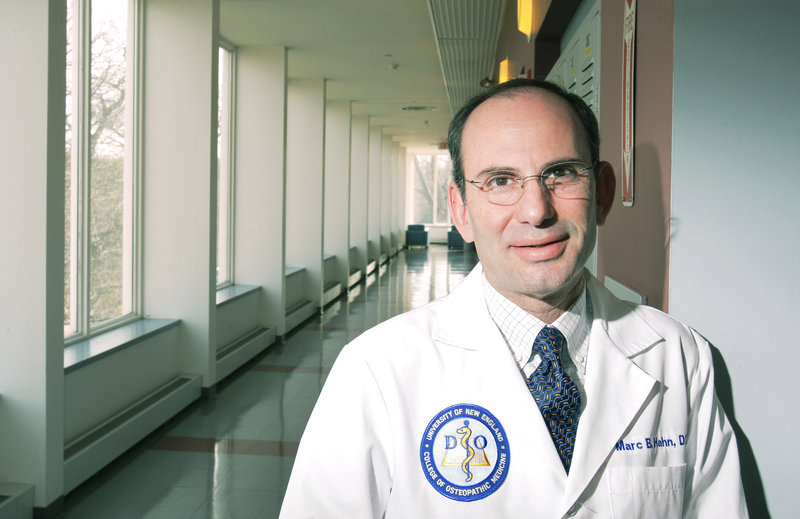The University of New England was already planning to nearly double the size of its medical school in Biddeford.
Its timing couldn’t be better.
The health care reform law signed last week by President Obama will extend insurance to more than 30 million uninsured Americans. In Maine, that means that about 140,000 people will soon be more likely to see a primary care doctor than wait until they’re sick enough for the emergency room.
They might have to wait to get an appointment.
Maine already is in need of more primary care doctors, and the shortage was projected to get worse as baby boomers age and demand more medical services.
“There are about 100 unfilled openings for primary care physicians in the state right now,” said Marc Hahn, dean of UNE’s College of Osteopathic Medicine. The state also is in short supply of other medical professionals, including nurses, therapists and pharmacists.
“If we remained on the same trajectory that we were on before, we’re looking at some challenges in meeting the demand,” Hahn said. “Now, let’s look at the fact that the 30 to 35 million (people) are going to get coverage. They’ll all be in greater demand.”
There are efforts, in Maine and nationally, to head off this health care crunch. The new reform law itself includes provisions intended to increase the number of doctors to take on all the new patients.
Maine’s supply of family medicine physicians and other primary care doctors has been tightening for years.
One reason is that, nationally, the vast majority of medical school graduates are now going into specialties such as radiology or cardiology. Specialists can earn three or four times as much as primary care doctors, which is especially important when you start a career $200,000 in debt from medical school.
As a result, there have not been enough young family doctors taking over for the rising number of doctors reaching retirement age.
On the other side of the equation, demand continues to grow. Along with the availability of more medical tests and treatments, doctors and patients are more aggressive about preventive care as a way to avoid serious illness and expensive hospital stays.
Maine, meanwhile, is the oldest state in the nation, with about 14 percent of the population over the age of 65. In about a decade, one of every five Mainers is expected to be a senior citizen.
The situation in Maine right now isn’t as tight as in some parts of the nation. Maine has 1.5 primary care doctors per 1,000 residents, compared with a national average of 1.2, according to Hahn.
But that doesn’t mean it’s easy to find a doctor or get an appointment.
“It’s not unusual to have a three- to six-month wait, if a practice is accepting new patients at all. A lot of primary care physicians are full. They can’t accept more patients,” said Dr. Elisabeth Mock, a family doctor from Holden and president of the Maine Academy of Family Physicians.
The shortage has been more chronic in the rural parts of Maine, but it now exists statewide, the experts said.
Alyssa Eppich of South Portland said she sees her primary care doctor regularly to keep a close eye on her heart condition. It was easy to get an appointment until about a year ago, she said.
“Now, when I call to get an appointment with him, it can be up to two months to see him, unless it’s an emergency,” she said.
Expanding insurance coverage to more people could well make waiting times longer. That’s what happened in Massachusetts after the state adopted a universal health coverage policy in 2007 and practices were flooded with new patients who had been avoiding doctors.
Maine is in a better position than most states when it comes to the expected surge of new patients because of health care reform. About 11 percent of Mainers are now uninsured, compared with about 15 percent nationwide.
“The impact of covering the uninsured may not be seen as much in Maine as in other places,” Mock said. But, she said, “it is expected that primary care physicians will have an increased demand, and we’re not sure how we’re going to meet that demand.”
Many see promise in a new model of primary care that involves nurse practitioners, physician’s assistants and others taking on a larger role in the care. While widely favored as a way to contain costs, those professionals are increasingly in short supply, too.
The health care reform law will provide some help, according to physicians and others.
It includes a bonus — 10 percent higher reimbursement rates — for primary care physicians in rural practices. It also includes more subsidies for newly graduated physicians who work in underserved areas and additional money to expand care through community health centers, said Kevin Lewis, chief executive officer of the Maine Primary Care Association.
The association is working to lure more medical students into primary care medicine here, according to Lewis. It is even encouraging middle-schoolers and high-schoolers to consider the career.
Many hopes are riding on the University of New England and a new medical school program operated jointly by Maine Medical Center in Portland and Tufts University School of Medicine in Boston.
The Maine Med program offers a $25,000-per-year scholarship for students who promise to do part of their residencies in rural Maine, which expands services and encourages doctors to stay in the long term.
The school, which offers an M.D. or doctor of medicine degree, began teaching its first class of 36 future physicians last fall. Not coincidentally, 22 of the first-year students are from Maine.
“We believe if you attract qualified students from our own state, they’ll stay,” said Peter Bates, chief medical officer at Maine Medical Center and interim dean of the school. “We’ve shown there are a lot of smart, young people in Maine who would like to be in health care.”
UNE, meanwhile, has shown it is possible to produce a new generation of primary care physicians.
It works to attract future family doctors and encourages residencies in rural Maine. Although it also has seen a growing number of graduates choose specialties, about 60 percent of its graduates still go into primary care.
Many of them also stay in Maine. Fifteen percent of Maine’s primary care doctors, and 25 percent of those practicing in rural Maine, are UNE graduates with a D.O. or doctor of osteopathy degree, said Hahn, the UNE medical school dean.
Both the D.O. and M.D. degrees qualify a graduate for general practice.
“We’re still attracting students who are interested in primary care,” Hahn said.
In fact, the school had 3,400 applications for 124 slots in its newest class of medical students. The school is now planning to expand both faculty size and classroom space in order to increase the class size from 124 to 225 within five years.
“We saw the enhanced demand for our product,” he said.
Staff Writer John Richardson can be contacted at 791-6324 or at:
jrichardson@pressherald.com
Send questions/comments to the editors.





Success. Please wait for the page to reload. If the page does not reload within 5 seconds, please refresh the page.
Enter your email and password to access comments.
Hi, to comment on stories you must . This profile is in addition to your subscription and website login.
Already have a commenting profile? .
Invalid username/password.
Please check your email to confirm and complete your registration.
Only subscribers are eligible to post comments. Please subscribe or login first for digital access. Here’s why.
Use the form below to reset your password. When you've submitted your account email, we will send an email with a reset code.